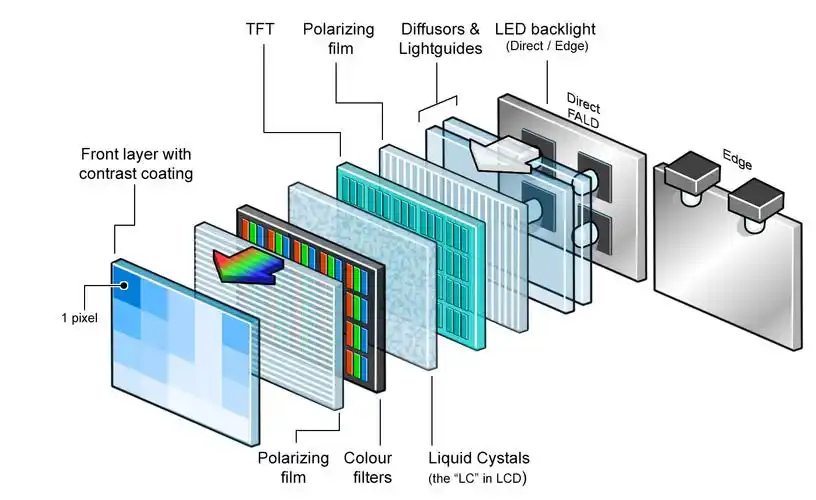Abstract
In our daily gazes at mobile phones, computers, and TVs, we rarely think: How can the screen content be clearly visible in a dark environment? The answer lies deep in the LCD screen – the backlight system. This precision optical engine, composed of light source, reflector, light guide plate, and optical film, silently defines visual quality and energy efficiency.

1. Light source revolution: Green transition from CCFL to LED
The core power source of the backlight system has undergone a fundamental change. Although the early cold cathode fluorescent lamp (CCFL) had excellent brightness, its high energy consumption and large size have become a technical shackle. White light LEDs have completely reshaped industry standards with their power consumption reduction of up to 40%(data from the U.S. Department of Energy), small size, and instant dimming. When OLED claims to be “self-luminous”, mainstream LCD screens are usingLED backlights to continue to evolve** and find a better balance between cost and performance.
2. Reflector: The Precision Game of Light Energy Guardians
Every ray of light is worth cherishing. The reflector is made of high-reflectivity PET or PMMA material, and the unique micron-level concave and convex texture on the surface is like a maze, returning the escaping light to the battlefield. The reflectivity is increased by 1%, and the overall brightness can be increased by 0.8% (study by SPIE Optical Engineering Society). This exquisite control of the photon path makes the backlight efficiency achieve a qualitative leap.
3. Light guide plate: the master of light uniformity
Uniformity is the soul of visual experience. PMMA light guide plate breaks the law of straight-line propagation of light through precisely calculated microstructure design – or laser engraved dots, or precision embossed prisms. The light is repeatedly refracted and scattered in the transparent medium, and finally spreads across the earth like morning light, achieving a surface uniformity of more than 92% (display industry benchmark), so that the screen bids farewell to annoying light and dark patches.
4. Optical film: invisible magic for visual enhancement
Optical film system is the ultimate shaper of picture quality. Brightness enhancement film (BEF) gathers light through a prism structure to double the axial brightness; diffusion film eliminates moiré and laser interference; and the application of composite quantum dot film pushes the color gamut to more than 110% of NTSC (such as Samsung QLED technology). The superposition of these nano-scale films creates a visual spectacle with rich colors and strong contrast.
5. Thinning Wave: The Sustainable Proposition of Structural Innovation
“Thinner” is the eternal pursuit of consumer electronics. The edge-entry LED combined with ultra-thin light guide plate technology has made the thickness of mobile phone screens break through the 1mm mark. New micro-structured light guide plates (such as the microlens array of Apple Pro Display XDR) replace some optical films, maintaining optical performance while reducing thickness. Material scientists are exploring nano-scale polymers (such as the ultra-thin flexible light guide material reported in the journal Nature) to pave the way for folding and curling screens.
6. Future Light: Evolution of Intelligence and Immersion
When Mini LED backlight achieves pixel-level light control with thousands of microchips (such as iPad Pro), the peak experience of HDR effect has arrived. For VR/AR, the backlight system is moving towards 5000nits ultra-high brightness (recommended standard of Stanford VR Laboratory) and millisecond-level response. The integration of ambient light sensor and AI algorithm allows the screen to intelligently adjust energy consumption and achieve a delicate balance between extreme vision and green battery life.
Summary
Every beat of the “optical heart” of the backlight system is pushing the boundaries of visual experience. From the green revolution of LED light source to the magic of light guide plate uniform light, from nano-level reflective texture to the color gamut leap of quantum dot film, technological innovation builds a temple of light and shadow in a small space.
When the future screen is as thin and curled as paper, and when the light and shadow of virtual and real are seamlessly blended, the backlight system will continue to write the dialogue between humans and the information world in the language of light. This illuminated horizon will eventually become a window to perceive infinite possibilities.
Authoritative reference:
- U.S. Department of Energy LED Energy Saving Data
- SPIE Journal of the Society for Optical Engineering
- SID Display Week Technical Report
- Nature Materials Science Paper
- IEEE Virtual Reality Technology White Paper
